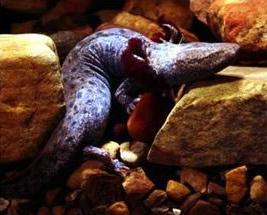Vermont Denies Mudpuppies Protection

Mudpuppies are the only completely aquatic salamanders in the Champlain Valley. Photo courtesy of Wikipedia.
The native mudpuppy, a large salamander that lives in rivers along Lake Champlain, was denied a spot on Vermont's Endangered Species List for the second time since 2002. The Endangered Species Committee and Natural Resource Secretary Deb Markowitz are in disagreement on whether sufficient data exists to warrant protection for the salamander. The mudpuppy's primary threat is lampricide, a pesticide used to kill parasitic sea lamprey. Lampricide treatment of the Lamoille River in 2009 killed more than 500 mudpuppies.
Markowitz is quoted as saying "I understand that it is the (Endangered Species Committee) and the (Scientific Advisory Group’s) belief that there is adequate evidence to support a listing of the mudpuppy, and that even if there were not, that the precautionary principal should apply when dealing with a species that may be at risk requiring intervention as early as possible," but that "in this instance I do not find sufficient evidence to list the mudpuppy as a threatened species under Vermont’s Endangered Species Act. However, because we support the precautionary principal we will be continuing to take steps to limit negative impacts on this species and to continue to gather data to help us make a decision about whether this species needs additional protection."
Referring to the lampricide treatments, Jim Andrews, chair of the Science Advisory Group said, “The bar is being held higher for mudpuppies because there is a potential conflict with a recreational fishery.” The mudpuppy is the only completely aquatic salamander in the Champlain Valley. Individuals can grow up to 14 inches long. They spend most of their lives near cover in waters up 60 feet deep but move upstream or to shorelines to lay eggs.
